Societal Narratives on Caregivers in Asia
Abstract
1. Introduction
2. Materials and Methods
2.1. Dataset
2.2. Measurement of Narratives on Caregivers and Analytic Strategy
3. Results
3.1. Size of Conversations
3.2. Societal Narratives on Caregivers across Six Asian Countries
3.2.1. Asia
3.2.2. Sri Lanka
3.2.3. India
3.2.4. Hong Kong
3.2.5. Philippines
3.2.6. Malaysia
3.2.7. Singapore
4. Discussion
4.1. Sri Lanka
4.2. India
4.3. Hong Kong
4.4. Philippines
4.5. Malaysia
4.6. Singapore
4.7. Pan-Asian Societal Narratives on Caregivers
5. Conclusions
Supplementary Materials
Author Contributions
Funding
Data Availability Statement
Acknowledgments
Conflicts of Interest
References
- United Nations; Department of Economic and Social Affairs; Population Division. World Population Ageing 2017-Highlights; United Nations: New York, NY, USA, 2017; ISBN 978-92-1-151551-0. [Google Scholar]
- Shaji, K.S.; Reddy, M.S. Caregiving: A Public Health Priority. Indian J. Psychol. Med. 2012, 34, 303–305. [Google Scholar] [CrossRef]
- Schulz, R.; Tompkins, C.A. Informal Caregivers in the United States: Prevalence, Caregiver Characteristics, and Ability to Provide Care; National Research Council (US) Committee on the Role of Human Factors in Home Health Care, National Academies Press (US): Washington, DC, USA, 2010.
- Schulz, R. Family caregiving roles and impacts. In Families Caring for an Aging America; Schulz, R., Eden, J., Eds.; National Academies Press (US): Cambridge, MA, USA, 2016. [Google Scholar]
- Reinhard, S.C.; Feinberg, L.F.; Houser, A.; Choula, R.; Evans, M. Valuing the Invaluable: 2019 Update: Charting a Path Forward; AARP Public Policy Institute: Washington, DC, USA, 2019. [Google Scholar]
- Atwood, J. Family Therapy and Chronic Illness, 1st ed.; Routledge: New York, NY, USA, 2010. [Google Scholar]
- Roth, D.L.; Fredman, L.; Haley, W.E. Informal Caregiving and Its Impact on Health: A Reappraisal From Population-Based Studies. Gerontologist 2015, 55, 309–319. [Google Scholar] [CrossRef] [PubMed]
- Zhang, Y.; Yeung, W.-J.J. Shifting Boundaries of Care in Asia: An Introduction. Int. J. Sociol. Soc. Policy 2012, 32, 612–622. [Google Scholar] [CrossRef]
- Barber, S.L.; Rosenberg, M. Aging and Universal Health Coverage: Implications for the Asia Pacific Region. Health Syst. Reform 2017, 3, 154–158. [Google Scholar] [CrossRef] [PubMed]
- Guo, M.; Kim, S.; Dong, X. Sense of Filial Obligation and Caregiving Burdens Among Chinese Immigrants in the United States. J. Am. Geriatr. Soc. 2019, 67, S564–S570. [Google Scholar] [CrossRef]
- Ngan, R.; Cheng, I.C.K. The Caring Dilemma: Stress and Needs of Caregivers for the Chinese Frail Elderly. Hong Kong J. Gerontol. 1992, 6, 34–41. [Google Scholar]
- Holroyd, E. Developing a Cultural Model of Caregiving Obligations for Elderly Chinese Wives. West. J. Nurs. Res. 2005, 27, 437–456. [Google Scholar] [CrossRef] [PubMed]
- Davies, M. The New 4.3 Billion Word NOW Corpus, with 4–5 Million Words of Data Added Every Day. In Proceedings of the 9th International Corpus Linguistics Conference, Birmingham, UK, 24–28 July 2017. [Google Scholar]
- Gerbner, G.; Gross, L.; Morgan, M.; Signorielli, N.; Shanahan, J. Growing up with television: Cultivation processes. In Media Effects: Advances in Theory and Research, 2nd ed.; Bryant, J., Zillmann, D., Eds.; LEA’s communication series; Lawrence Erlbaum Associates Publishers: Mahwah, NJ, USA, 2002; pp. 43–67. ISBN 978-0-8058-3863-3. [Google Scholar]
- Church, K.W.; Hanks, P. Word Association Norms, Mutual Information, and Lexicography. Comput. Linguist. 1990, 16, 22–29. [Google Scholar] [CrossRef]
- Ng, R. Societal Age Stereotypes in the U.S. and U.K. from a Media Database of 1.1 Billion Words. Int. J. Environ. Res. Public Health 2021, 18, 8822. [Google Scholar] [CrossRef]
- Ng, R.; Chow, T.Y.J. Aging Narratives over 210 Years (1810–2019). J. Gerontol. Ser. B 2020, gbaa222. [Google Scholar] [CrossRef]
- Ng, R.; Chow, T.Y.J.; Yang, W. Culture Linked to Increasing Ageism during COVID-19: Evidence from a 10-Billion-Word Corpus across 20 Countries. J. Gerontol. Ser. B 2021, gbab057. [Google Scholar] [CrossRef] [PubMed]
- Ng, R.; Chow, T.Y.J.; Yang, W. News Media Narratives of Covid-19 across 20 Countries: Early Global Convergence and Later Regional Divergence. PLoS ONE 2021, 16, e0256358. [Google Scholar] [CrossRef] [PubMed]
- Ng, R.; Indran, N. Societal Perceptions of Caregivers Linked to Culture across 20 Countries: Evidence from a 10-Billion-Word Database. PLoS ONE 2021, 16, e0251161. [Google Scholar] [CrossRef] [PubMed]
- Ng, R.; Indran, N. Role-Based Framing of Older Adults Linked to Decreased Ageism Over 210 Years: Evidence From a 600-Million-Word Historical Corpus. Gerontologist 2021, gnab108. [Google Scholar] [CrossRef] [PubMed]
- Ng, R.; Indran, N. Reframing Aging during COVID-19: Familial Role-Based Framing of Older Adults Linked to Decreased Ageism. J. Am. Geriatr. Soc. 2021, in press. [Google Scholar] [CrossRef] [PubMed]
- Ng, R.; Allore, H.G.; Trentalange, M.; Monin, J.K.; Levy, B.R. Increasing Negativity of Age Stereotypes across 200 Years: Evidence from a Database of 400 Million Words. PLoS ONE 2015, 10, e0117086. [Google Scholar] [CrossRef] [PubMed]
- Ng, R.; Lim, W.J. Ageism Linked to Culture, Not Demographics: Evidence From an 8-Billion-Word Corpus Across 20 Countries. J. Gerontol. Ser. B 2020, gbaa181. [Google Scholar] [CrossRef]
- Asian Development Bank. Growing Old Before Becoming Rich-Asian Development Bank; Asian Development Bank: Manila, Philippines, 2019. [Google Scholar]
- Watt, M.H.; Perera, B.; Østbye, T.; Ranabahu, S.; Rajapakse, H.; Maselko, J. Caregiving Expectations and Challenges among Elders and Their Adult Children in Southern Sri Lanka. Ageing Soc. 2014, 34, 838–858. [Google Scholar] [CrossRef]
- Prasanna, S.M.S.; Cader, T.S.B.; Sabalingam, S.; Shanika, L.G.T.; Samaranayake, N.R. Are Medications Safely Used by Residents in Elderly Care Homes?–A Multi-Centre Observational Study from Sri Lanka. PLoS ONE 2020, 15, e0233486. [Google Scholar] [CrossRef]
- Ugargol, A.P.; Bailey, A. Family Caregiving for Older Adults: Gendered Roles and Caregiver Burden in Emigrant Households of Kerala, India. Asian Popul. Stud. 2018, 14, 194–210. [Google Scholar] [CrossRef]
- Roy, S.; Ayalon, L. “Goodness and Kindness”: Long Distance Caregiving through Volunteers during the COVID-19 Lockdown in India. J. Gerontol. Ser. B 2020, gbaa187. [Google Scholar] [CrossRef]
- Rajan, S.I.; Balagopal, G. Caring India: An Introduction. In Elderly Care in India: Societal and State Responses; Irudaya Rajan, S., Balagopal, G., Eds.; Springer: Singapore, 2017; ISBN 978-981-10-3438-1. [Google Scholar]
- Nagpal, V.; Kapoor, S. Child Care Options for Low Income Working Parents from Urban Slums and Jhuggies. Int. J. Appl. Home Sci. 2015, 2, 231–234. [Google Scholar]
- Senthilingam, M. This Urban Population Is Leading the World in Life Expectancy. Available online: https://www.cnn.com/2018/03/02/health/hong-kong-world-longest-life-expectancy-longevity-intl/index.html (accessed on 1 October 2021).
- Hui, S. Red Flag as Birth Rate Hits 40-Year Low. Available online: https://www.thestandard.com.hk/section-news/section/11/230743/Red-flag-as-birth-rate-hits-40-year-low (accessed on 1 October 2021).
- Lam, T.; Yeoh, B.S.A. Parental Migration and Disruptions in Everyday Life: Reactions of Left-behind Children in Southeast Asia. J. Ethn. Migr. Stud. 2019, 45, 3085–3104. [Google Scholar] [CrossRef]
- Lam, J. Give Family Carers Better Support, Think Tank Says. Available online: https://www.scmp.com/news/hong-kong/education-community/article/2097863/give-family-carers-better-support-allow-elderly (accessed on 1 October 2021).
- Cheung, E. Hong Kong Carers Have a ‘High Risk’ of Health Problems, Survey Finds. Available online: https://www.scmp.com/news/hong-kong/health-environment/article/2169197/hong-kongs-elderly-carers-are-high-risk-physical (accessed on 1 October 2021).
- Wong, P.K.S.; Yeung, R.C.F.; Fung, M.H.Y. Impact of Caring on Hong Kong Family Caregivers of People with Disabilities. In Proceedings of the 3rd Transforming Care Conference: Innovation and Sustainability, Milan, Italy, 26–28 June 2017. [Google Scholar]
- Bai, X.; Lai, D.W.L.; Liu, C. Personal Care Expectations: Photovoices of Chinese Ageing Adults in Hong Kong. Health Soc. Care Community 2020, 28, 1071–1081. [Google Scholar] [CrossRef]
- Yeates, N. Global Care Chains. Int. Fem. J. Politics 2004, 6, 369–391. [Google Scholar] [CrossRef]
- Lorenzo, F.M.E.; Galvez-Tan, J.; Icamina, K.; Javier, L. Nurse Migration from a Source Country Perspective: Philippine Country Case Study. Health Serv. Res. 2007, 42, 1406–1418. [Google Scholar] [CrossRef]
- Parreñas, R.S. Mothering from a Distance: Emotions, Gender, and Intergenerational Relations in Filipino Transnational Families. Fem. Stud. 2001, 27, 361–390. [Google Scholar] [CrossRef]
- McBride, M.R. Working with Filipino American Families. In Ethnicity and the Dementias; Taylor & Francis Group: New York, NY, USA, 2006; pp. 189–207. ISBN 978-0-415-95405-1. [Google Scholar]
- Badana, A.N.S.; Andel, R. Aging in the Philippines. Gerontologist 2018, 58, 212–218. [Google Scholar] [CrossRef] [PubMed]
- The World Bank Population Ages 65 and above (% of Total Population)-Singapore, Sri Lanka, India, Hong Kong SAR, China, Malaysia, Philippines |Data. Available online: https://data.worldbank.org/indicator/SP.POP.65UP.TO.ZS?end=2020&locations=SG-LK-IN-HK-MY-PH&start=2016&view=chart (accessed on 30 September 2021).
- Laguna, E.P. Caring for Older Persons. In Ageing and Health in the Philippines; Cruz, G.T., Cruz, C.J.P., Saito, Y., Eds.; Economic Research Institute for ASEAN and East Asia: Jakarta, Indonesia, 2019; pp. 173–192. [Google Scholar]
- Bidin, A.; Yusoff, J.Z.M. Abuse of the Malaysian Elderly: An Analysis on the Adequacy and Suitability of the Domestic Violence Act 1994 (Act 521) to Protect the Elderly Victim. J. Manag. Res. 2015, 7, 71. [Google Scholar] [CrossRef]
- Schiamberg, L.B.; Gans, D. An Ecological Framework for Contextual Risk Factors in Elder Abuse by Adult Children. J. Elder Abuse Negl. 1999, 11, 79–103. [Google Scholar] [CrossRef]
- Batumalai, K. What Malaysia Needs for Healthy Ageing and Care. Available online: https://codeblue.galencentre.org/2020/11/17/what-malaysia-needs-for-healthy-ageing-and-care/ (accessed on 1 October 2021).
- Chai How This M’sian Startup Modernises Elderly Care So That Nursing Homes Aren’t The Only Option. Vulcan Post. 2020. Available online: https://vulcanpost.com/686850/care-concierge-elderly-homecare-malaysia/ (accessed on 6 October 2021).
- Ghazali, S.; Abdullah, K.L.; Abd Aziz, A.; Mohd Amin, R.; Jusoh, A.S.; Mansor, M.; Wan Abudul Rahman, W.N.A.; Mohd Shafie, Z. Burden of Caregivers of the Elderly with Chronic Illnesses and Their Associated Factors in an Urban Setting in Malaysia. Malays. J. Public Health Med. 2015, 15, 1–9. [Google Scholar]
- Jawahir, S.; Tan, E.H.; Tan, Y.R.; Mohd Noh, S.N.; Ab Rahim, I. The Impacts of Caregiving Intensity on Informal Caregivers in Malaysia: Findings from a National Survey. BMC Health Serv. Res. 2021, 21, 391. [Google Scholar] [CrossRef]
- The World Bank GDP per Capita, PPP (Constant 2017 International $)-Singapore, Sri Lanka, India, Hong Kong SAR, China, Malaysia, Philippines|Data. Available online: https://data.worldbank.org/indicator/NY.GDP.PCAP.PP.KD?end=2020&locations=SG-LK-IN-HK-MY-PH&start=1990&view=chart (accessed on 30 September 2021).
- Yeung, W.-J.J.; Thang, L.L. Long-Term Care for Older Adults in ASEAN Plus Three: The Roles of Family, Community, and the State in Addressing Unmet Eldercare Needs. J. Aging Health 2018, 30, 1499–1515. [Google Scholar] [CrossRef]
- Chin, C.W.W.; Phua, K.-H. Long-Term Care Policy: Singapore’s Experience. J. Aging Soc. Policy 2016, 28, 113–129. [Google Scholar] [CrossRef]
- Chia, N.; Khoo, M. Transforming Community Care in 2030. Available online: https://www.csc.gov.sg/articles/transforming-community-care-in-2030 (accessed on 1 October 2021).
- Tang, L. The Big Read: Strides Made in Eldercare, but Concerns Arise over Affordability and Lack of Information. Available online: https://www.todayonline.com/singapore/big-read-strides-made-eldercare-concerns-arise-over-affordability-and-lack-information (accessed on 1 October 2021).
- Yamada, M.; Arai, H. Long-Term Care System in Japan. Ann. Geriatr. Med. Res. 2020, 24, 174–180. [Google Scholar] [CrossRef]
- McPherson, C.J.; Wilson, K.G.; Murray, M.A. Feeling like a Burden: Exploring the Perspectives of Patients at the End of Life. Soc. Sci. Med. 2007, 64, 417–427. [Google Scholar] [CrossRef] [PubMed]
- Burgdorf, J.; Roth, D.L.; Riffin, C.; Wolff, J.L. Factors Associated With Receipt of Training among Caregivers of Older Adults. JAMA Intern. Med. 2019, 179, 833–835. [Google Scholar] [CrossRef]
- Tan, C.-E.; Hi, M.-Y.; Azmi, N.S.; Ishak, N.K. Caregiving Self-Efficacy and Knowledge Regarding Patient Positioning Among Malaysian Caregivers of Stroke Patients. Cureus 2020, 12, e7390. [Google Scholar] [CrossRef] [PubMed]
- Wong, C.S.C.; Zelman, D.C. Caregiver Expressed Emotion as Mediator of the Relationship between Neuropsychiatric Symptoms of Dementia Patients and Caregiver Mental Health in Hong Kong. Aging Ment. Health 2020, 24, 1690–1699. [Google Scholar] [CrossRef] [PubMed]
- Maduwage, S. Situational Overview of Elder Abuse in Sri Lanka. In International Handbook of Elder Abuse and Mistreatment; Springer: Singapore, 2020; pp. 427–437. ISBN 9789811386107. [Google Scholar]
- Amrith, M. ‘They Think We Are Just Caregivers’: The Ambivalence of Care in the Lives of Filipino Medical Workers in Singapore. Asia Pac. J. Anthropol. 2010, 11, 410–427. [Google Scholar] [CrossRef]
- Ng, R.; Tan, K.B. Implementing an Individual-Centric Discharge Process across Singapore Public Hospitals. Int. J. Environ. Res. Public Health 2021, 18, 8700. [Google Scholar] [CrossRef]
- Ng, R.; Lim, S.Q.; Saw, S.Y.; Tan, K.B. 40-Year Projections of Disability and Social Isolation of Older Adults for Long-Range Policy Planning in Singapore. Int. J. Environ. Res. Public Health 2020, 17, 4950. [Google Scholar] [CrossRef]
- Ng, R.; Allore, H.G.; Levy, B.R. Self-Acceptance and Interdependence Promote Longevity: Evidence From a 20-Year Prospective Cohort Study. Int. J. Environ. Res. Public Health 2020, 17, 5980. [Google Scholar] [CrossRef] [PubMed]
- Ng, R. Cloud Computing in Singapore: Key Drivers and Recommendations for a Smart Nation. Politics Gov. 2018, 6, 39–47. [Google Scholar] [CrossRef]
- Giest, S.; Ng, R. Big Data Applications in Governance and Policy. Politics Gov. 2018, 6, 1–4. [Google Scholar] [CrossRef]
- Ng, R.; Levy, B. Pettiness: Conceptualization, Measurement and Cross-Cultural Differences. PLoS ONE 2018, 13, e0191252. [Google Scholar] [CrossRef] [PubMed]
- Heidekrueger, P.I.; Juran, S.; Szpalski, C.; Larcher, L.; Ng, R.; Broer, P.N. The Current Preferred Female Lip Ratio. J. Cranio Maxillofac. Surg. 2017, 45, 655–660. [Google Scholar] [CrossRef]
- Ng, R.; Allore, H.G.; Monin, J.K.; Levy, B.R. Retirement as Meaningful: Positive Retirement Stereotypes Associated with Longevity. J. Soc. Issues 2016, 72, 69–85. [Google Scholar] [CrossRef] [PubMed]
- Sima, L.C.; Ng, R.; Elimelech, M. Modeling Risk Categories to Predict the Longitudinal Prevalence of Childhood Diarrhea in Indonesia. Am. J. Trop. Med. Hyg. 2013, 89, 884–891. [Google Scholar] [CrossRef]
- Ng, R. Douglas, Mary. Encycl. Cross Cult. Psychol. 2013, 439–440. [Google Scholar] [CrossRef]
- Ng, R. Cultural Theory. Encycl. Cross Cult. Psychol. 2013, 333–335. [Google Scholar] [CrossRef]
- Ng, R. Cultural Intelligence. Encycl. Cross Cult. Psychol. 2013, 310–313. [Google Scholar] [CrossRef]
- Ng, R. Cultural Cognition. Encycl. Cross Cult. Psychol. 2013, 300–301. [Google Scholar] [CrossRef]
- Ng, R.; Ang, R.P.; Ho, M.-H.R. Coping with Anxiety, Depression, Anger and Aggression: The Mediational Role of Resilience in Adolescents. Child Youth Care Forum 2012, 41, 529–546. [Google Scholar] [CrossRef]
- Steglitz, J.; Ng, R.; Mosha, J.S.; Kershaw, T. Divinity and Distress: The Impact of Religion and Spirituality on the Mental Health of HIV-Positive Adults in Tanzania. AIDS Behav. 2012, 16, 2392–2398. [Google Scholar] [CrossRef] [PubMed]
- Ng, R.; Rayner, S. Integrating Psychometric and Cultural Theory Approaches to Formulate an Alternative Measure of Risk Perception. Innov. Eur. J. Soc. Sci. Res. 2010, 23, 85–100. [Google Scholar] [CrossRef]
- Ng, R.; Tan, Y.W. Diversity of COVID-19 News Media Coverage across 17 Countries: The Influence of Cultural Values, Government Stringency and Pandemic Severity. Int. J. Environ. Res. Public Health 2021. under review. [Google Scholar]
- Ng, R.; Wong, P.S.H. Marginalization of Graduate Freelancers in the Gig Economy. Jpn. Labor Issues 2021, 32, 67–84. [Google Scholar]

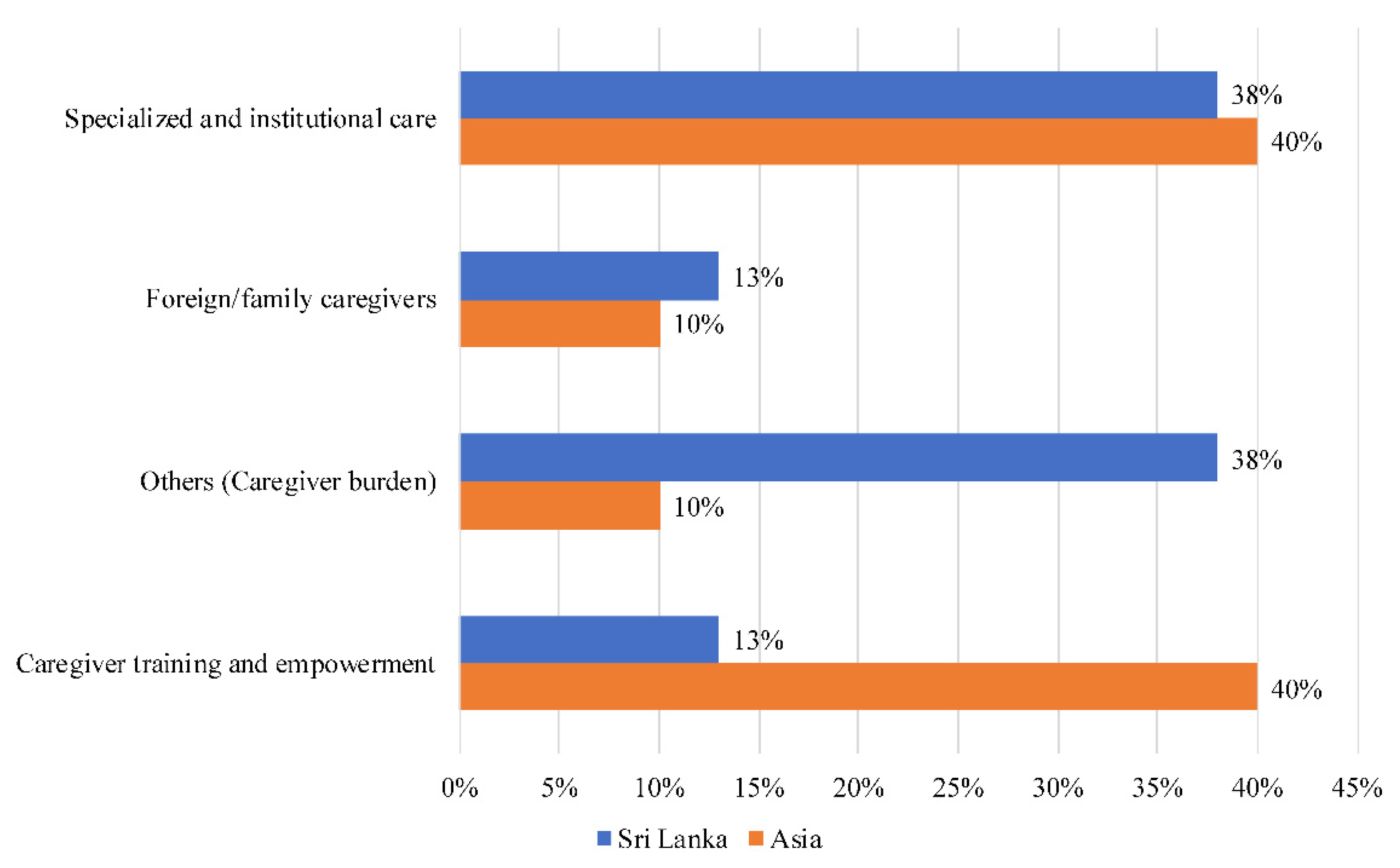
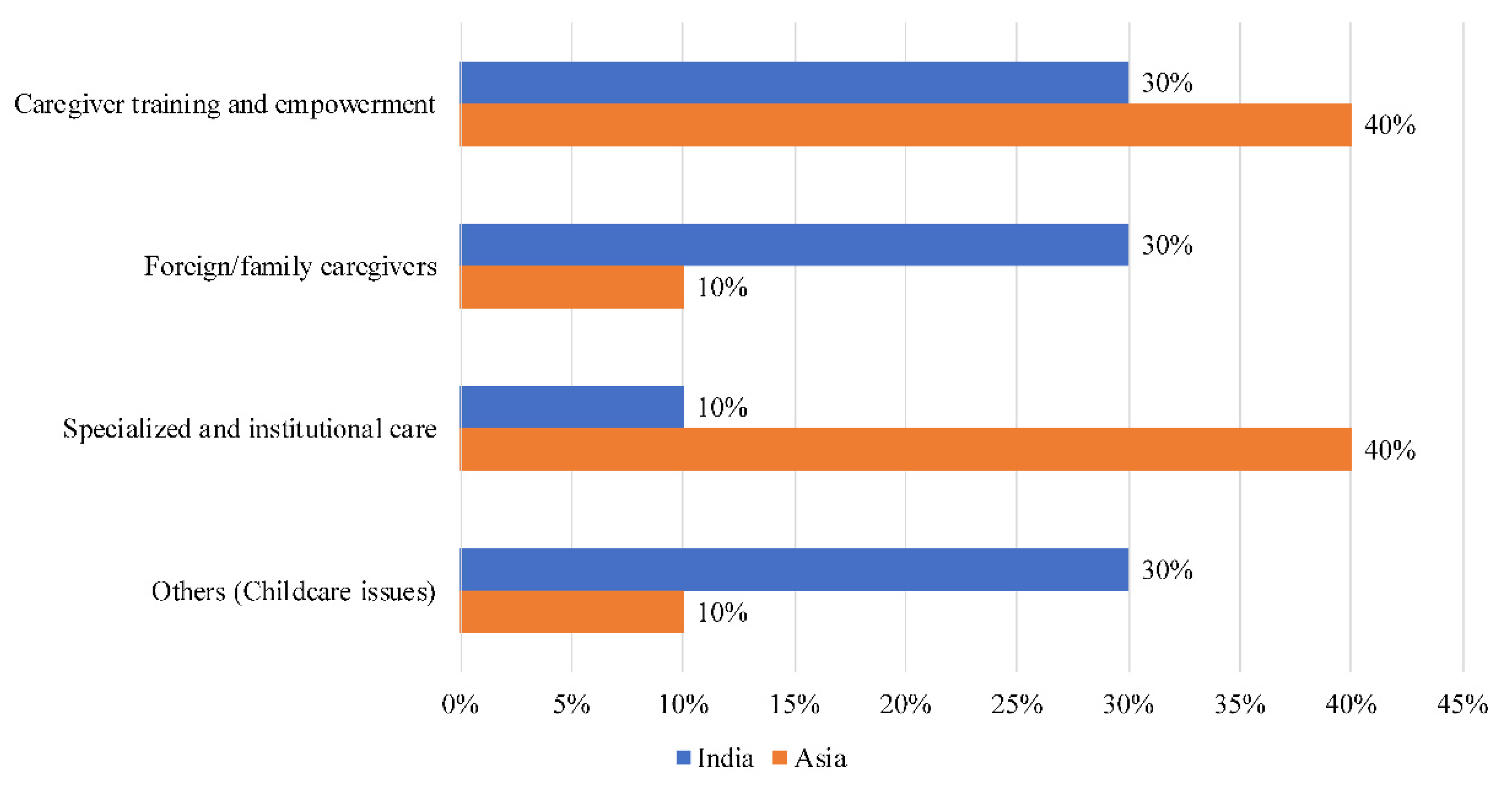
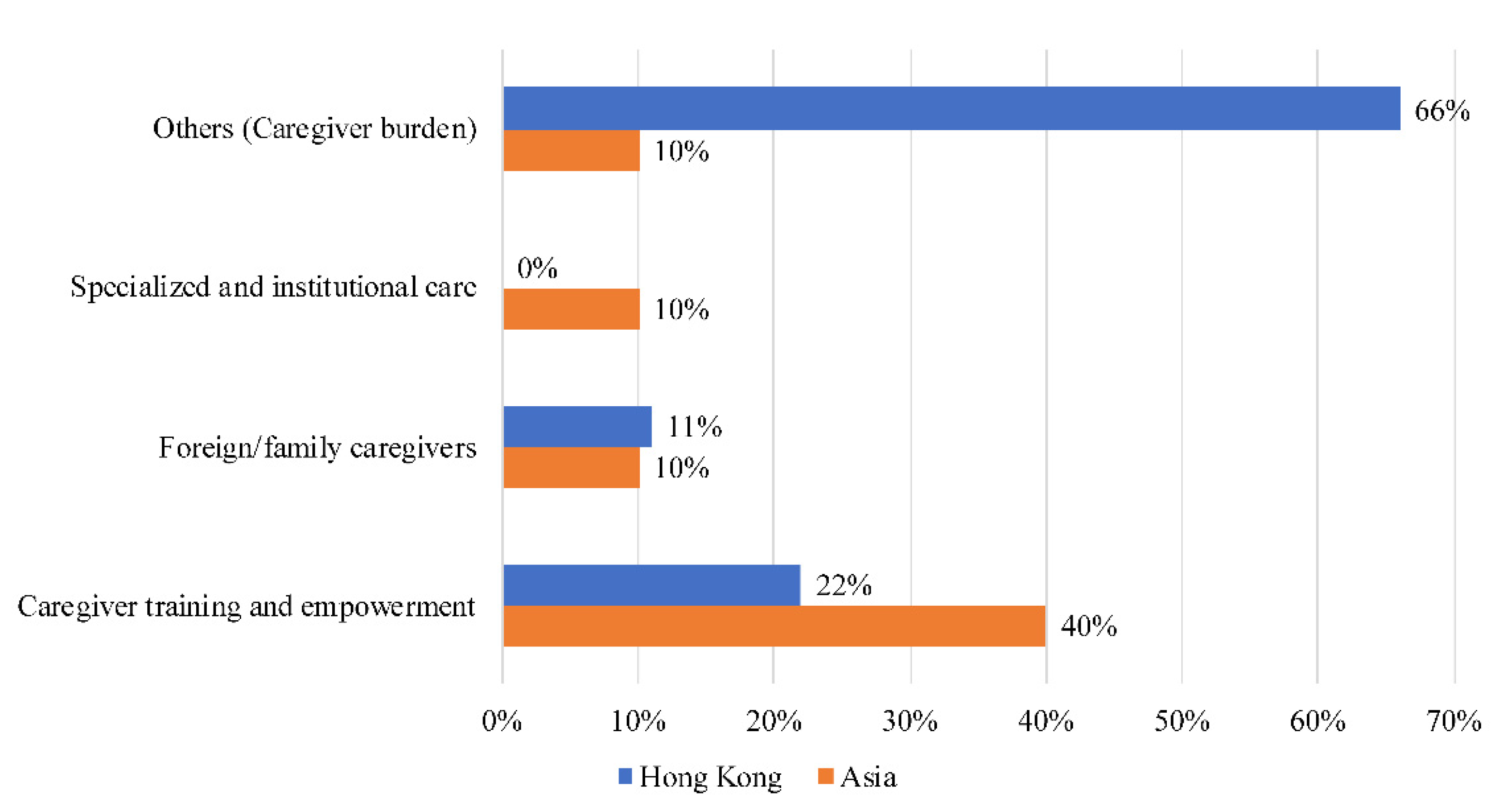
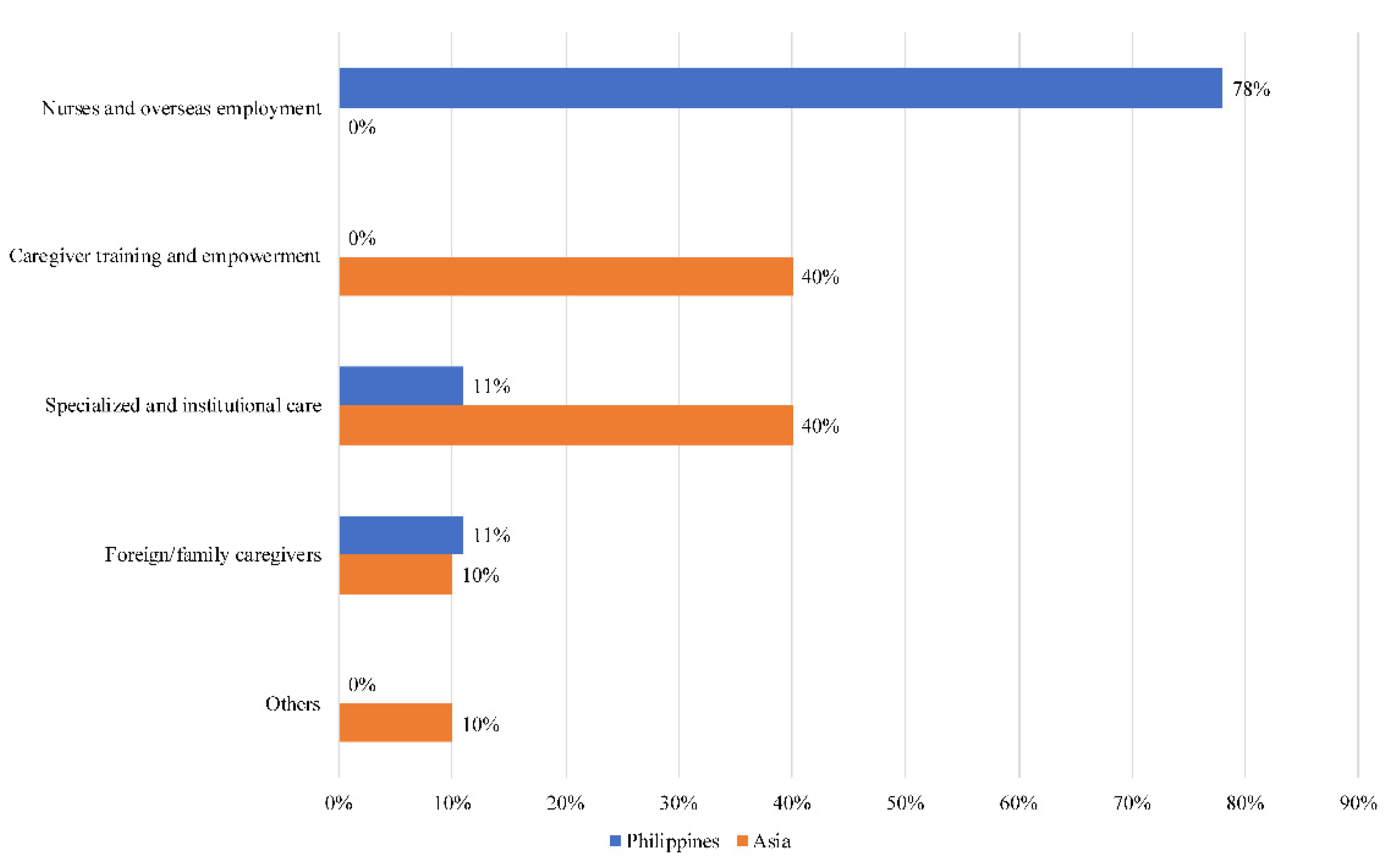
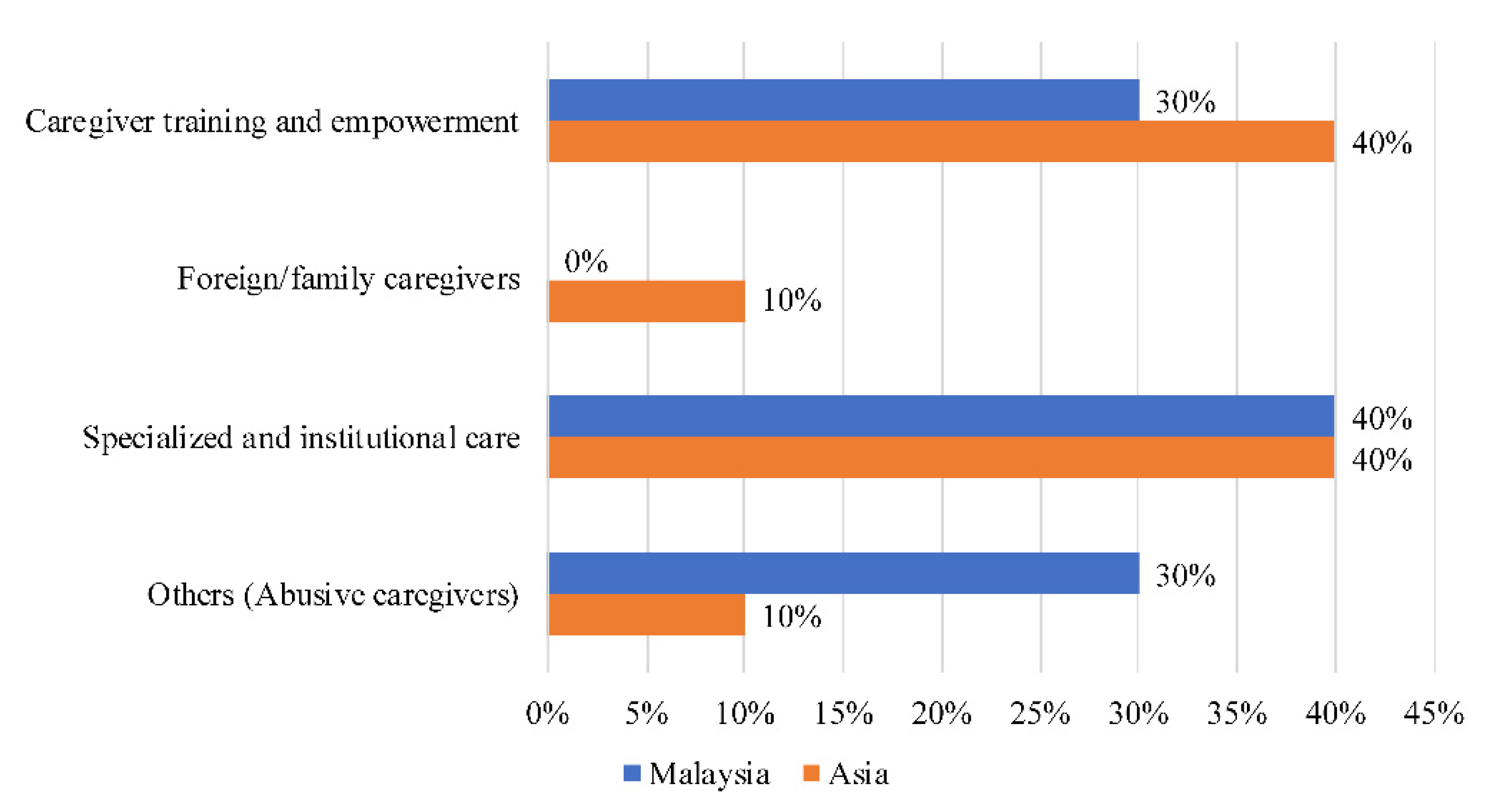
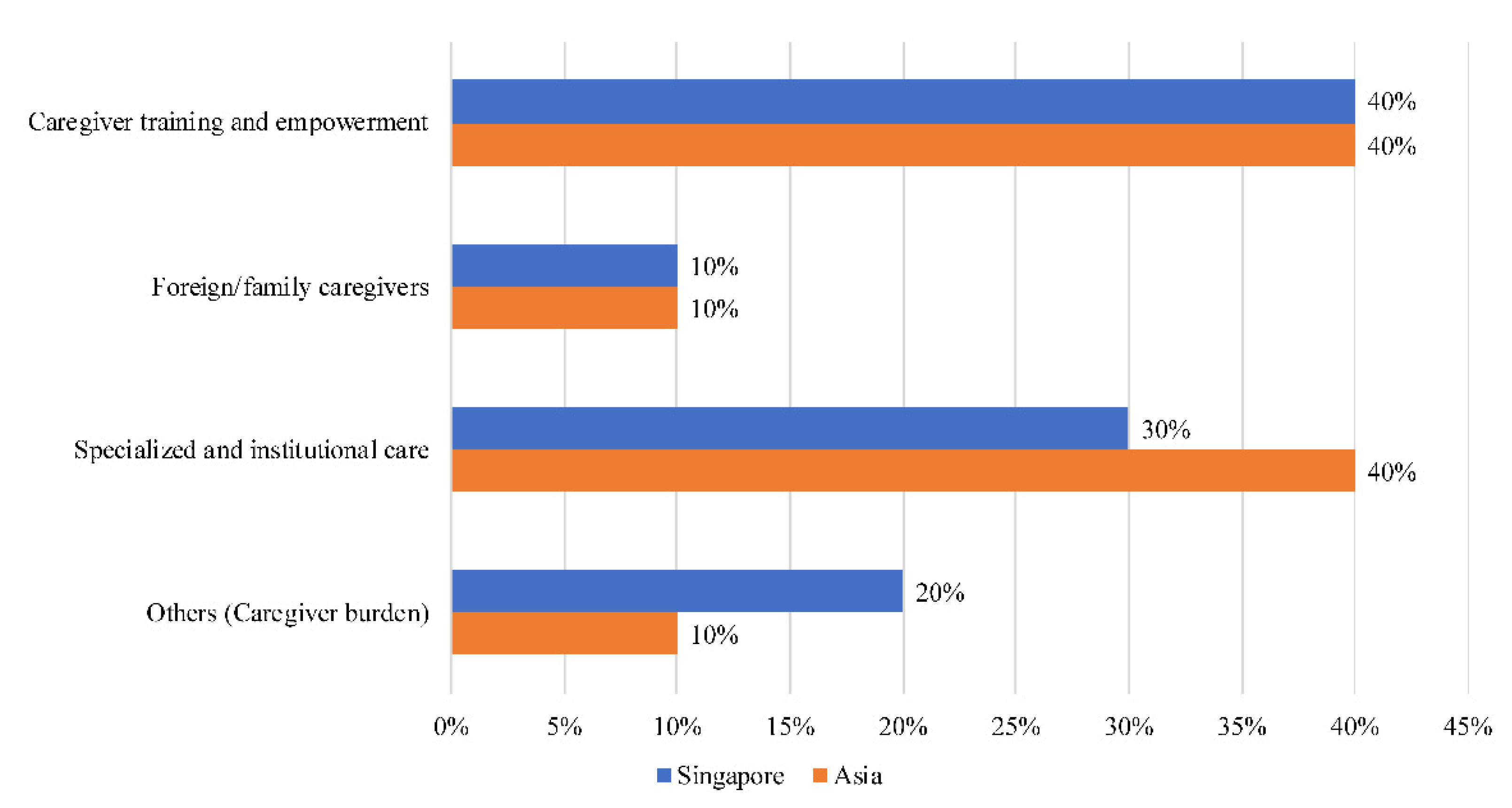
| Country | Topic | Collocates (Keywords) |
|---|---|---|
| Sri Lanka | Specialized and institutional care | Organization, provision, physician, diagnosis, knowledge, information, sufficient |
| Caregiver burden | Illness, depression, suffer, health, condition, disabling, work, huge, sole | |
| Foreign caregivers | Italian, northern, memorandum, profession, nursing, sector, midwifery, dearth, severe | |
| Caregiver training and empowerment | Development, facilitate, awareness, raise, better, sole, demand, suffer, target | |
| India | Caregiver training and empowerment | Training, support, program, learn, share group, discussion, experience, education, information |
| Family caregivers | Family, role, support, care, parent, rule, govern, social, Indian, loved | |
| Childcare issues | Infant, child, scheme, patient, abuse, report, help | |
| Specialized and institutional care | Hospital, patient, visit, staff, nurse, stay, require | |
| Hong Kong | Caregiver burden | Stress, toll, mental, health, relationship, family, psychiatrist, complain, alarming, lack |
| Caregiver training and empowerment | Support, organization, volunteer, care, recruit, family, selfless, stress, parent | |
| Foreign caregivers | Filipino, foreign, worker, care, center, organizer, resource | |
| Philippines | Nurses training and overseas employment | Filipino, abroad, work, nurse, domestic, hire, care, child, job, worker |
| Specialized and institutional care | Hospital, professional, worker, patient, care, robot, support | |
| Family caregivers | Parent, partner, spouse, relative, mother, designated, learn | |
| Malaysia | Caregiver training and empowerment | Support, training, education, course, public, attend, learn, health, care, train |
| Specialized and institutional care | Hire, employ, recruit, private, nurse, facilitate, care, qualify, technology, implementation | |
| Abusive caregivers | Abuse, report, parent, incident, difficult, trained, increase, more | |
| Singapore | Caregiver training and empowerment | Support, training, initiative, share, experience, information, volunteer, train |
| Specialized and institutional care | Voluntary, welfare, center, association, resident, support, professional, patient, organize, cost | |
| Family caregivers | Parent, compassionate, caring, care, loved, special, elderly | |
| Caregiver burden | Burden, stress, challenge, condition, mental, illness, pressure, encourage, support |
Publisher’s Note: MDPI stays neutral with regard to jurisdictional claims in published maps and institutional affiliations. |
© 2021 by the authors. Licensee MDPI, Basel, Switzerland. This article is an open access article distributed under the terms and conditions of the Creative Commons Attribution (CC BY) license (https://creativecommons.org/licenses/by/4.0/).
Share and Cite
Ng, R.; Indran, N. Societal Narratives on Caregivers in Asia. Int. J. Environ. Res. Public Health 2021, 18, 11241. https://doi.org/10.3390/ijerph182111241
Ng R, Indran N. Societal Narratives on Caregivers in Asia. International Journal of Environmental Research and Public Health. 2021; 18(21):11241. https://doi.org/10.3390/ijerph182111241
Chicago/Turabian StyleNg, Reuben, and Nicole Indran. 2021. "Societal Narratives on Caregivers in Asia" International Journal of Environmental Research and Public Health 18, no. 21: 11241. https://doi.org/10.3390/ijerph182111241
APA StyleNg, R., & Indran, N. (2021). Societal Narratives on Caregivers in Asia. International Journal of Environmental Research and Public Health, 18(21), 11241. https://doi.org/10.3390/ijerph182111241






